How to Remove Webhelper Virus in 3 Easy Steps 2025
Webhelper is a malicious adware program that can infect your computer and put you at serious risk. Webhelper isn’t a subtle virus — you’ll know when you have it. The telltale sign is it’ll be using a substantial portion of your computer’s system resources, particularly CPU utilization.
Webhelper can give hackers remote access to your computer. It records your keystrokes, steals your confidential data, and bombards you with annoying pop-up ads.
You can get this virus by opening links in scam emails, clicking dodgy ads online, and using fake or infected torrent clients. Fortunately, though, it’s not that difficult to remove Webhelper from your system, but you can’t do it without a decent antivirus like Norton 360.
Remove Webhelper with Norton 360
Quick Guide: 3 Easy Steps to Remove Webhelper Virus
- Scan your computer — Run a full scan with a premium antivirus. I highly recommend Norton 360 because it has a perfect detection score.
- Remove Webhelper — Remove all malware and infections, including Webhelper, from the list of viruses your antivirus detects.
- Stay protected — Subscribe to a total security package from a reliable antivirus to ensure you don’t get infected in the future.
Remove Webhelper with Norton 360
How to Remove Webhelper Virus
Step 1: Scan your computer
First, you must download and install a good antivirus program on your Windows PC or Mac. If you’re using a Windows device, I strongly recommend Norton 360. It detects 100% of infectious malware, even the stealthiest of viruses that hide deep in the most unassuming areas of your computer. In addition, it offers bonus features, such as a VPN, password manager, intelligent firewall, optimization tools, and parental controls, all of which add an extra layer of security to your PC.
If you’re a Mac user, finding a Mac-focused antivirus may be more complicated. However, there are a few good options worth checking out. As a regular Mac user myself, I use Norton to protect my Mac because it provides perfect detection, secure browsing, parental controls, and Mac optimization tools.
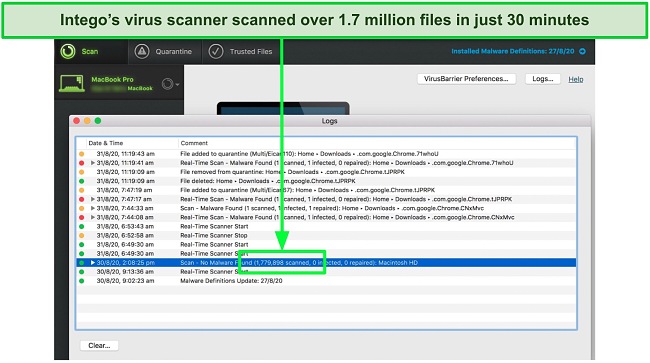
Once you’ve installed an antivirus on your computer, you’ll find multiple scan options like quick scan, custom scan, and full scan. Run a full scan because it’s comprehensive and scans every nook and cranny of your hard drive, so the chances of missing out on viruses are minimized.
Lastly, ensure that you don’t have any portable devices like USBs and external hard drives plugged into your system while scanning. Some viruses can circumvent the scan by hiding in portable storage devices during a full scan.
Step 2: Remove Webhelper
After the full scan has finished, your antivirus will show you a list of detected viruses. Webhelper will be one of the items on the list. You can delete all the entries at once or check each item individually to make sure it’s not a safe file that has been mistakenly marked as infected. Some antiviruses flag safe files, so I’d recommend going through the search list item by item. I’ve never had this issue with Norton, though.
One full scan should be enough if you’re using a top-tier antivirus. However, I still recommend you run it a second time to be 100% sure Webhelper and other malware are entirely removed from your system.
After each scan, you’ll be prompted to restart your computer. If not, you still should, as it would wipe out any remaining malicious processes running on your computer even after the viruses have been removed.
Step 3: Stay protected
Removing Webhelper from your computer isn’t enough — you need to make sure you don’t get infected again. You need to keep your operating system up to date, secure your wireless network, and have an antivirus security suite that guards you against threats on all fronts.
First, be cautious of what you’re downloading and from where. Malicious files can appear safe, so don’t download them unless you’re 100% sure they’re safe. Second, don’t click on malicious links in spam emails. As a rule of thumb, I delete them without even opening them.
In addition, you should always keep your device’s software, drivers, and operating system (OS) up to date. When you don’t update your OS, previous security vulnerabilities can’t be fixed. This means that the older your OS is, the more vulnerable it is to hackers. Most operating systems have an auto-update feature, which automatically keeps your drivers and OS updated.
Unfortunately, the auto-update feature doesn’t work with apps and programs installed on your device. It’s challenging to keep track of each app and update it manually every couple of days. However, some antiviruses like Avira let you update all apps and programs directly from their dashboard.
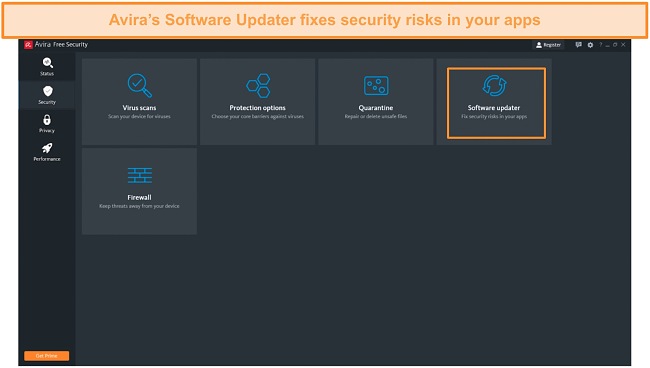
You can’t keep threats at bay without securing your wireless network. Your wireless internet connection should be secured, preferably with a WPA2-PSK protocol, so hackers can’t easily infiltrate your network and use it to access your computer.
Set up a strong router password of at least 15 characters, containing a combination of letters, numbers, and special characters. Lastly, always keep your firewall on; a firewall monitors your incoming and outgoing internet traffic and connections 24/7. So, if someone tries accessing your internet network or computer remotely, the firewall will immediately notify you and block it.
While Windows systems and Macs host their native firewalls, they might not be enough to protect you from threats all the time, especially a Windows firewall. I strongly recommend you get an antivirus like Norton 360, which has an intelligent firewall and offers a wide array of features that add extra layers of security to your computer.
Editor’s Note: We value our relationship with our readers, and we strive to earn your trust through transparency and integrity. We are in the same ownership group as some of the industry-leading products reviewed on this site: ExpressVPN, Cyberghost, Private Internet Access, and Intego. However, this does not affect our review process, as we adhere to a strict testing methodology.
The Best Antivirus Software to Remove Webhelper Virus — Full Test Results in 2025
1. Norton 360 — 100% Detection Rate and Perfect Real-Time Protection
Key Features:
- Perfect malware detection and real-time protection
- AI-powered malware engine (SONAR)
- Intelligent firewall
- Extra features include VPN, password manager, browser extension, and parental controls.
- 60-day money-back guarantee
I tested Norton 360 extensively, and it delivered exceptional performance on all fronts. I planted several viruses on my testing machine, including trojans, rootkits, spyware, etc. I run Norton’s full scan, which took about 13 minutes and was pleased to see that it detected all of them.
After that, I run Norton’s Quick Scan, which sifted through 11,000 files in just 2 minutes! Compared to other antiviruses, Norton’s scans are significantly faster and, surprisingly, much lighter on your system, too. Norton’s perfect detection scores can be attributed to its advanced AI-powered SONAR analysis, which identifies new threats by matching their behavior to known threats.
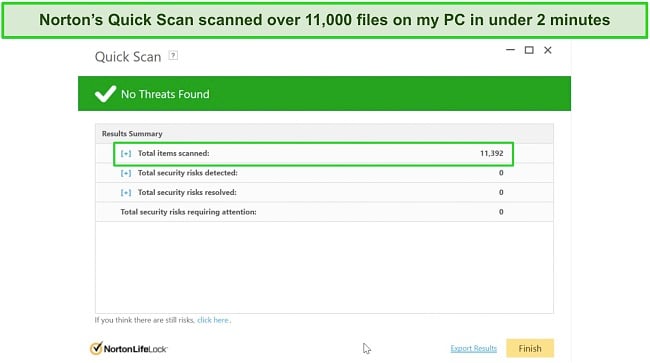
Norton also packs a Safe Web browser extension, making surfing the internet completely safe. It blocked me from downloading a malicious file containing Webhelper and even blocked dangerous websites from opening. Using this extension guarantees 100% real-time protection against all online threats.

A virus-like Webhelper can steal your data by recording what you type on your keyboard, but you can avoid that by using a well-integrated password manager. I used Norton’s password manager, and it saved all my passwords in one place and auto-filled them whenever I needed them.
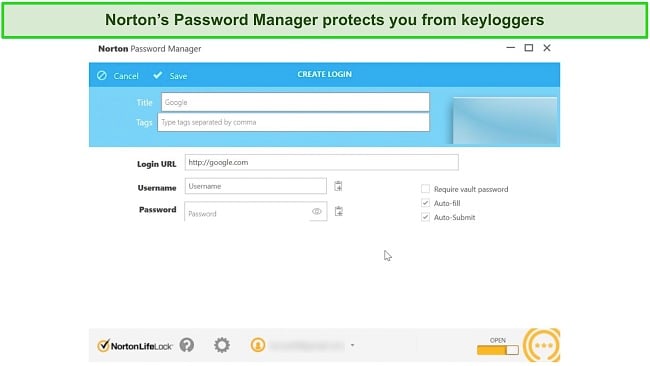
Another symptom of having Webhelper on your computer is that it slows your PC down significantly. Norton’s optimization tools can stop malicious processes from hogging your CPU resources and boost system performance. I used its Optimize Disk feature to remove junk and duplicate files and clear up some space on my hard drive.
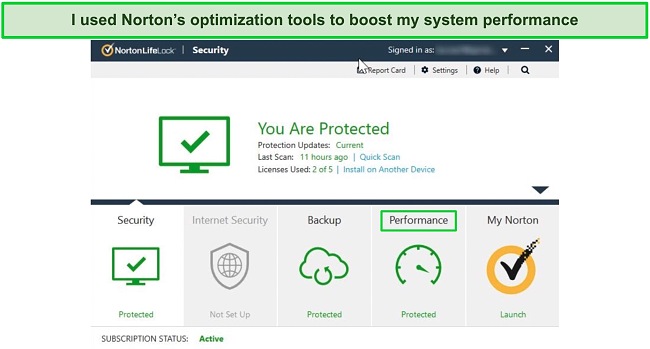
Norton 360 is my go-to antivirus for all my Windows devices. Apart from the above features, it hosts parental controls that let you monitor your child’s device(s) and a highly configurable firewall with tons of features for advanced users.
Overall, it provides exceptional security to your devices, making them invulnerable to internal and external threats. If you don’t want to commit just yet, I recommend you try Norton out risk-free with its generous 60-day money-back guarantee.
Remove Webhelper with Norton 360
2. McAfee — Configurable Firewall With Excellent Security Features
Key Features:
- Perfect detection and near-perfect real-time protection
- Use cloud-based Global Threat Intelligence to detect fast-emerging threats
- Highly configurable firewall
- Additional features include password manager, browser extension, VPN, parental controls, and file shredder
- 30-day free trial and 60-day money-back guarantee
I put McAfee through the same rigorous testing as I had Norton and was pleased to see that it detected 100% of the malware I had planted on my computer. It provides 3 scan options — Quick Scan, Full Scan, and Custom Scan. I ran Quick Scan, and it scanned critical areas on my computer in under 5 minutes. The full scan, however, took about an hour to finish.
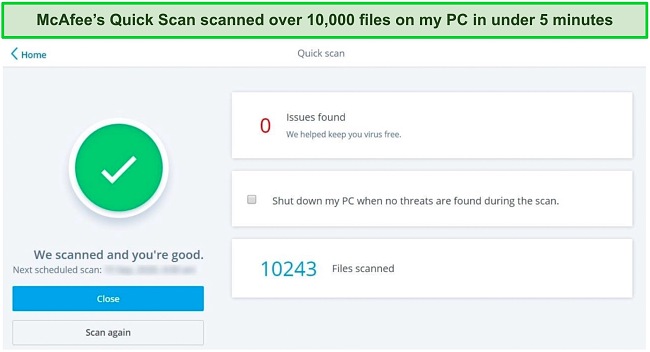
I also liked McAfee’s Vulnerability Scanner, which automatically detects if your OS and apps need to be updated. This is a handy feature when dealing with viruses like Webhelper that are known to exploit vulnerable spots on your computer. I found it incredibly easy to use. Instead of checking updates for each app individually, you can get all of them in one place.
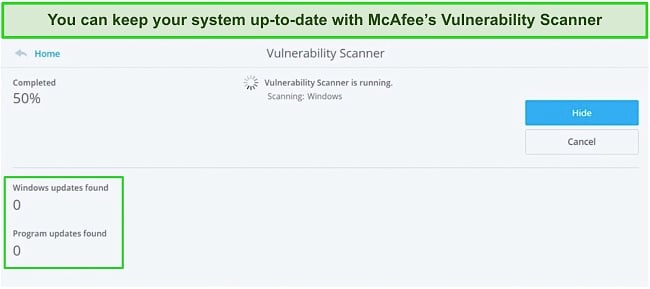
When it comes to real-time protection, McAfee is one of the strongest contenders after Norton 360. Its WebAdvisor browser extension effectively blocked malicious downloads, websites, phishing scams, and crypto-jacking malware, protecting me from 98.8% of malicious websites and links.
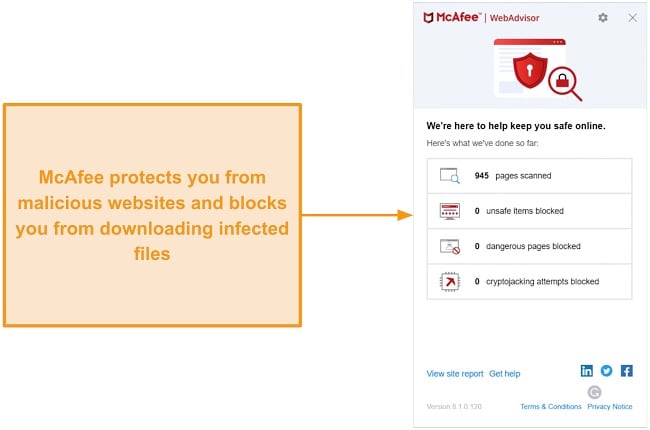
McAfee’s True Key password manager was a joy to use, but, unfortunately, it only lets you store up to 15 passwords. You’ll have to pay extra if you want to save more passwords, which is disappointing since other antiviruses like TotalAV let you save unlimited passwords without charging you extra.
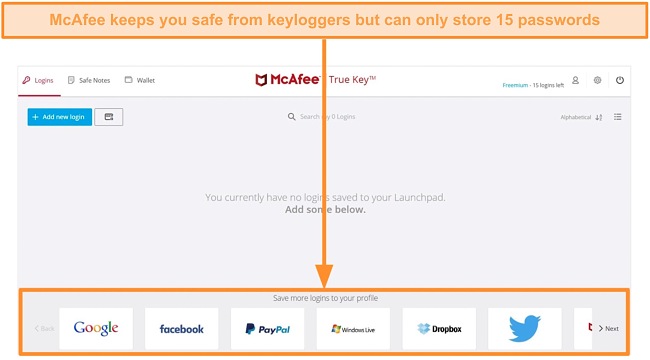
True Key isn’t just a password manager but also a wallet and note-keeping tool. I used the Safe Notes feature to securely store my social security details and credit card information. It uses military-grade AES 256-bit encryption to protect your confidential data.
Apart from that, McAfee hosts a powerful and customizable firewall with several advanced features that give you complete control over your PC’s security. I especially liked its Intrusion Detection detection feature, which instantly alerts you if a hacker gains remote access to your computer. The Net Guard feature protects you from suspicious network connections.
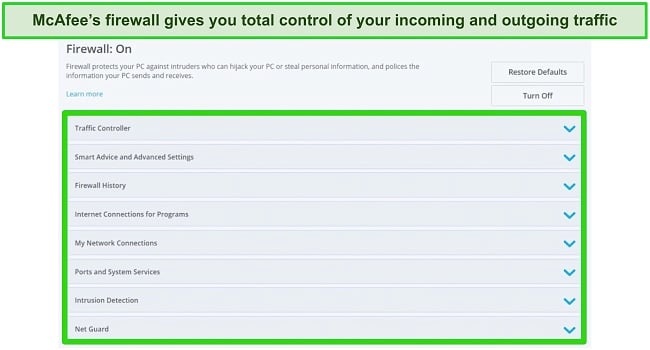
McAfee is an excellent option that provides exceptional security for your computer. It’s a complete security package that hosts a browser extension, VPN, password manager, and parental controls. It also provides a 60-day money-back guarantee on top of a 30-day free trial, so you can try it out risk-free for more than a month.
3. TotalAV — Plenty of Optimization Tools to Boost System Performance
Key Features:
- Perfect malware detection and 99% real-time protection scores
- Browser extension that keeps online threats at bay
- Suite of optimization and tune-up tools
- Extra features include VPN, password manager, and data leak protection
- 30-day money-back guarantee
TotalAV is a relatively new antivirus in the industry, but after testing it extensively, I’m pleased to say that it delivers performance at par with top antiviruses. It provides 3 scan options — Smart Scan, Full Scan, and Custom Scan.
I used Smart Scan and found it offered much more than the Quick Scan feature on other antiviruses. It not only scanned critical areas of my computer but also provided me with recommendations on how to optimize my PC’s performance.
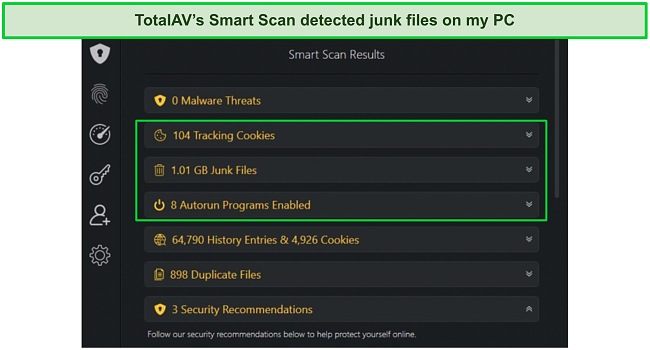
I also ran the full system scan and was happy to find that TotalAV detected all the malware I had planted on my PC. The only catch was it took a little more than an hour for the full scan to finish. I also noticed that it hampered my PC’s performance, especially when I tried downloading resource-heavy apps like Adobe Suite during the full scan.
As far as real-time protection is concerned, TotalAV blocked 99.2% of all cyberattacks, including potentially dangerous websites and malicious downloads. That’s an excellent score, especially provided that the industry average is only 97%.
I pitted its WebShield browser extension against several online threats, and TotalAV came out on top every time. You can use WebShield on Chrome, Edge, Firefox, and Opera, but, unfortunately, it does not have an extension for Safari.
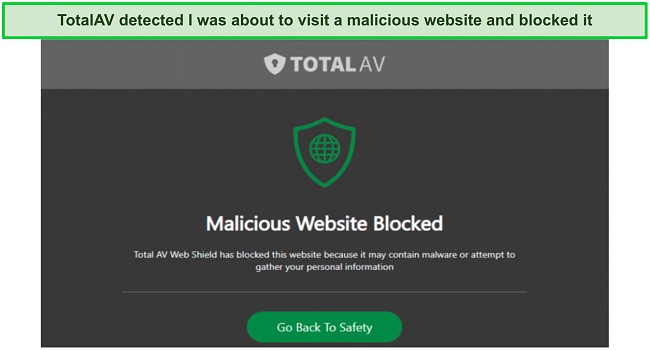
I compared TotalAV’s impact on my system performance with Norton’s. I found that Norton was almost 4 times as fast and used significantly fewer resources than TotalAV.
TotalAV vs Norton — CPU Resources
| Test Type | Control CPU Utilization % (no scan) | Control Memory Utilization % (no scan) | Control Disk Utilization (MB/s) (no scan) | Full Scan CPU Utilization % | Full Scan Memory Utilization % | Full Scan Disk Utilization (MB/s) |
| Norton | 14 | 72 | 13 | 84 | 75 | 381 |
| TotalAV | 81 | 75 | 332 | 100 | 82 | 101 |
What makes TotalAV stand out is its optimization tools. I was happy to see a wide array of optimization tools in its arsenal — the ones I liked most were Disk Cleaner and Startup Manager. The Disk Cleaner scans your hard drive for any junk files, tracker cookies, duplicate files, and unwanted program files, boosting your system performance.
I used the Startup Manager to see which programs launched automatically on system boot-up. TotalAV provided me with a long list of apps that I didn’t want open at startup, including Skype, VLC, and uTorrent, among many others. I disabled them and noticed that my PC had gotten noticeably faster. This is a nifty feature to optimize system performance.
TotalAV also goes the extra mile to protect you from spyware like Webhelper that steals your data. It hosts an in-built data breach test that automatically alerts you if your data has been compromised. A feature like this is valuable for data and identity protection.
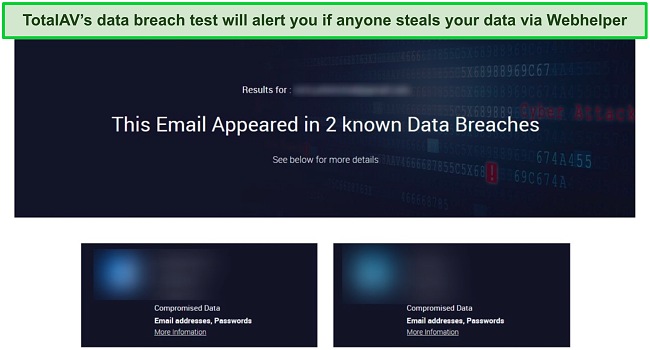
In addition, TotalAV provides a whitelist VPN from Windscribe and a secure password vault that stores unlimited passwords. Unfortunately, it doesn’t offer parental controls, and its firewall doesn’t have many advanced features. Despite these limitations and a lack of features, it comes in third place on my list, but I still consider TotalAV an excellent option if all you need is a top-notch malware remover.
Comparison Table: 2025’s Best AVs for Removing Webhelper Virus
| Real-time Protection | Optimization Tools | Parental Controls | Identity Protection | Cloud Backup | |
| Norton 360 | ✔ | ✔ | ✔ | ✔ | ✔ |
| McAfee | ✔ | ✔ | ✔ | ✔ | ✘ |
| TotalAV | ✔ | ✔ | ✘ | ✘ | ✘ |
Remove Webhelper with Norton 360
How I Tested and Ranked the Best AVs for Removing Webhelper
I determined each antivirus’s efficacy by considering the following aspects:
- Malware detection score — I picked only those antiviruses that provided me with a perfect or near-perfect detection score.
- Real-time protection — I checked how useful each antivirus’s real-time protection features, such as browser extension.
- System performance — I monitored how resource-intensive each antivirus is and picked the ones that won’t slow your PC down as much.
- Extra features — I chose antiviruses that provide total security, providing additional features like a password manager, VPN, and parental controls.
- Optimization tools — I picked antiviruses that provide optimization tools, such as a disk cleaner and junk/duplicate files remover.
Remove Webhelper with Norton 360
FAQs: How to Remove Webhelper Virus
1. Is Webhelper a virus?
Yes, Webhelper is a malicious program that can put you at serious risk. Hackers use Webhelper to access your webcam and browsing details and even record your mouse clicks and keystrokes to steal your confidential data, such as bank account information and more.
If you find Webhelper running in your task manager, know that your computer is infected and your data is at risk. However, you can remove this virus by installing a good antivirus like Norton 360.
2. How did Webhelper get on my PC?
The most likely channel for Webhelper to get on your PC is malicious downloads. These could be scam emails with infected links or uTorrent downloads. As a rule of thumb, never download files from a website or client unless you’re 100% certain they’re reliable and safe.
Fortunately, there’s a way to remove Webhelper if it has found its way onto your computer. Just follow these 3 simple steps to remove it permanently from your system, ensuring you don’t get infected in the future.
3. What does Webhelper do?
A computer infected with Webhelper will have many symptoms. You’ll notice that it’s eating up a significant portion of your CPU resources, slowing down your PC. Other than that, you’ll see frequent pop-up ads and unexpected sounds may be played randomly.
Webhelper can also record your keystrokes and mouse clicks, stealing your bank details and passwords. Additionally, it can control other programs on your computer and exploit their vulnerabilities to let in more viruses on your computer. Luckily, you can easily remove Webhelper using a good antivirus.
Remove Webhelper with Norton 360
Stay Safe from Malicious Programs like Webhelper
Webhelper is a serious risk to your privacy. It lets hackers gain remote access to your computer and steal your confidential information, including bank account information or social security details. If you’re not sure your PC is infected with this virus, you can check if it’s running in your task manager under the “Processes” tab.
Once you know you have Webhelper, you must remove it immediately. It’s easy to do that — just follow this 3-step guide. Keep in mind that Webhelper is not a potentially unwanted program (PUP) that you can remove from the “Uninstall programs” section in the Control Panel — you can only remove it using a good antivirus.
I strongly recommend using Norton 360 because it has one of the best malware detection and real-time protection scores. The software also offers a range of additional features including a password manager, VPN, parental controls, and optimization tools, guaranteeing comprehensive protection for all your devices.
If you’re looking for a cheaper alternative but one that offers equally exceptional protection, McAfee Total Protection is a good option. It provides all the features you need to protect yourself against viruses like Webhelper. You can use McAfee’s 60-day money-back guarantee on top of the 30-day free trial, getting a risk-free period of 90 days.



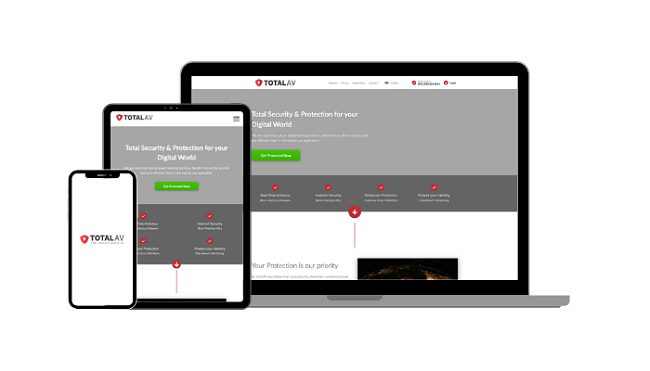


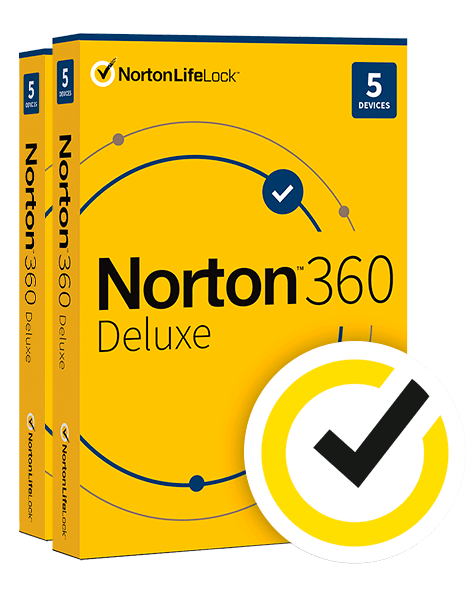
Leave a Comment
Cancel